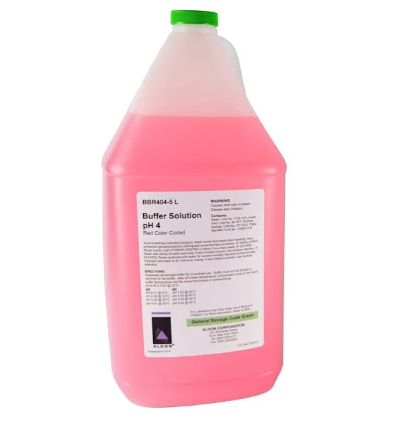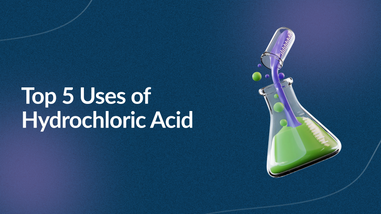- No products in the cart.
In the intricate world of laboratory science and industrial processes, mastering the art of pH control is a critical aspect that directly impacts the outcome of experiments and manufacturing processes. Among the various pH levels, pH4 stands out as a key benchmark. In this blog, we delve into the science behind buffer pH4, exploring its significance, applications, and the meticulous techniques involved in achieving mastery over pH control.
Understanding pH: The Basics
pH, or "potential of hydrogen," is a measure of the acidity or alkalinity of a solution. It is a logarithmic scale ranging from 0 to 14, where lower values indicate acidity, higher values indicate alkalinity, and a pH of 7 is neutral. Buffer solutions play a vital role in maintaining a stable pH, preventing drastic changes that could alter the conditions of a given system.
The Power of Four: Why Buffer pH4?
Buffers come in all shapes and sizes, each tailored for specific pH ranges. Among them, buffer pH4, often formulated with acetic acid and its conjugate base acetate, takes center stage in various scientific and industrial applications.
Why is pH4 so special? The answer lies in its versatility. At pH4, the weak acid and its conjugate base exist in roughly equal concentrations, creating a buffer zone that effectively resists changes within the range of pH 3 to pH 5. This makes it ideal for:
- Biochemistry: Many biological processes, like enzyme activity and protein stability, are highly sensitive to pH fluctuations. Buffer pH4 safeguards these delicate reactions by maintaining a near-neutral environment, vital for cellular functions.
- Analytical Chemistry: Calibrating pH meters and controlling the acidity of analytical solutions often require a stable pH reference point. Buffer pH4, with its predictable and resistant nature, serves as a reliable benchmark for accurate measurements.
- Food Science: Maintaining optimal acidity in food products is crucial for taste, texture, and microbial control. Buffer pH4 finds application in preserving fruits, stabilizing beverages, and ensuring food safety.
Beyond the Basics: Advanced Buffering Techniques
Mastering pH control requires understanding the nuances of buffer behavior. Here are some advanced techniques to fine-tune your buffer prowess:
- Buffer capacity: This refers to the amount of acid or base a buffer can absorb before its pH significantly changes. Higher buffer concentrations provide greater capacity, catering to situations requiring strong resistance to pH shifts.
- Ionic strength: The presence of other ions can affect a buffer's performance. Adjusting the ionic strength of the solution through the addition of salts can optimize buffer capacity and stability.
- Temperature dependence: Buffering capacity and pKa (the acid dissociation constant) can vary with temperature. Consider temperature adjustments when designing buffers for specific applications.
Unveiling the Science Behind pH4 Buffer Solutions
The magic of pH control lies in the composition of buffer solutions. A buffer typically consists of a weak acid and its corresponding conjugate base. For buffer pH4, acetic acid (CH₃COOH) and acetate ions (CH₃COO⁻) serve as a common choice.
-
Acetic Acid-Acetate Buffer System:
-
Equilibrium Dynamics: Acetic acid, a weak acid, partially ionizes in water to produce acetate ions and hydronium ions (H₃O⁺). The equilibrium between these species regulates the pH.
-
Buffering Capacity: The presence of both the weak acid and its conjugate base allows the system to resist drastic changes in pH when an acid or base is added. This buffering capacity is crucial for maintaining stability in various applications.
-
Meticulous Techniques for Achieving pH4 Mastery
Creating and maintaining a buffer solution at pH4 requires precision and attention to detail. Here are some key techniques employed in laboratories and industries:
-
Accurate Measurements:
-
pH Meter Calibration: Regular calibration of pH meters ensures accurate readings. Calibrating to standard solutions with known pH values is a fundamental step in achieving reliability.
-
Precise Quantities: Accurate measurement of the amounts of acetic acid and acetate ions is crucial. Even slight deviations can impact the pH of the solution.
-
-
Temperature Control:
-
Thermal Equilibration: Buffer solutions are sensitive to temperature changes. Allowing the solution to equilibrate to the desired temperature before use ensures consistent pH readings.
-
Thermoregulation Devices: In some setups, incorporating devices like water baths or temperature-controlled environments maintains the stability of the buffer solution.
-
-
Regular Monitoring and Adjustment:
-
pH Monitoring: Continuous monitoring of pH levels during experiments or processes is essential. Any deviations can be promptly corrected by adding small quantities of acid or base as needed.
-
Feedback Systems: In automated setups, incorporating feedback systems that adjust the addition of acids or bases based on real-time pH readings enhances precision.
-
Conclusion: A Symphony in pH4 Precision
Mastering the art of pH control at pH4 is a symphony of science, precision, and meticulous techniques. From the delicate balance of acetic acid and acetate ions to the careful calibration of instruments, each step contributes to the harmonious control of pH. Whether in a laboratory conducting groundbreaking research or in an industry shaping everyday products, the significance of pH4 mastery resonates across diverse fields. As we unravel the science behind buffer pH4, we gain not only insights into the intricacies of pH control but also an appreciation for the impact of this mastery on the world around us.
For over 40 years, Lab Pro Inc. has been committed to delivering highest quality lab chemicals, buffer solutions, lab supplies, hand tools, lab equipment, reagents, distance learning kits, and cleanroom PPE apparel. Renowned by global medical device companies and laboratories, we ensure exceptional quality in every product. Contact us online or call 888-452-2776 to learn more. Discover top-notch lab supplies and elevate your experiments today!



















































